Neuroscience For Kids
Neurotransmitters and Neuroactive Peptides
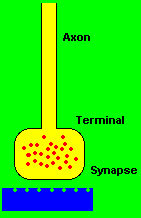 Communication of information between neurons is accomplished by
movement of chemicals across a small gap called the
synapse. Chemicals, called
neurotransmitters, are released from one neuron at the
presynaptic nerve terminal. Neurotransmitters then cross the synapse where they may be accepted by the next neuron
at a specialized site called a receptor. The action that follows
activation of a receptor site may be either depolarization (an excitatory
postsynaptic potential) or hyperpolarization (an inhibitory postsynaptic
potential). A depolarization makes it MORE likely that an action potential will fire; a hyperpolarization makes
it LESS likely that an action potential will fire.
Communication of information between neurons is accomplished by
movement of chemicals across a small gap called the
synapse. Chemicals, called
neurotransmitters, are released from one neuron at the
presynaptic nerve terminal. Neurotransmitters then cross the synapse where they may be accepted by the next neuron
at a specialized site called a receptor. The action that follows
activation of a receptor site may be either depolarization (an excitatory
postsynaptic potential) or hyperpolarization (an inhibitory postsynaptic
potential). A depolarization makes it MORE likely that an action potential will fire; a hyperpolarization makes
it LESS likely that an action potential will fire.
Discovery of Neurotransmitters
In 1921, an Austrian scientist named Otto Loewi discovered the first
neurotransmitter.  In
his experiment (which came to him in a dream), he used two frog hearts.
One heart (heart #1) was still connected to the vagus nerve. Heart #1 was
placed in a chamber that was filled with saline. This chamber was
connected to a second chamber that contained heart #2. So, fluid from
chamber #1 was allowed to flow into chamber #2. Electrical stimulation of
the vagus nerve (which was attached to heart #1) caused heart #1 to
slow down. Loewi also observed that after a delay, heart
#2 also slowed down. From this experiment, Loewi hypothesized that
electrical stimulation of the vagus nerve released a chemical into the
fluid of chamber #1 that flowed into chamber #2. He called this chemical
"Vagusstoff". We now know this chemical as the neurotransmitter called
acetylcholine.
In
his experiment (which came to him in a dream), he used two frog hearts.
One heart (heart #1) was still connected to the vagus nerve. Heart #1 was
placed in a chamber that was filled with saline. This chamber was
connected to a second chamber that contained heart #2. So, fluid from
chamber #1 was allowed to flow into chamber #2. Electrical stimulation of
the vagus nerve (which was attached to heart #1) caused heart #1 to
slow down. Loewi also observed that after a delay, heart
#2 also slowed down. From this experiment, Loewi hypothesized that
electrical stimulation of the vagus nerve released a chemical into the
fluid of chamber #1 that flowed into chamber #2. He called this chemical
"Vagusstoff". We now know this chemical as the neurotransmitter called
acetylcholine.
Otto Loewi's Experiment
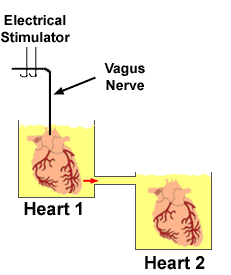

Neurotransmitter Criteria
Neuroscientists have set up a few guidelines or criteria to prove that a chemical is really a neurotransmitter. Not all of the neurotransmitters that you have heard about may actually meet every one of these criteria.
The chemical must be produced within a neuron. |
The chemical must be found within a neuron. |
When a neuron is stimulated (depolarized), a neuron must release
the chemical. |
When a chemical is released, it must act on a post-synaptic
receptor and cause a biological effect. |
After a chemical is released, it must be inactivated. Inactivation
can be through a reuptake mechanism or by an enzyme that stops the action
of the chemical. |
If the chemical is applied on the post-synaptic membrane, it should
have the same effect as when it is released by a
neuron. |
Neurotransmitter Types
There are many types of chemicals that act as neurotransmitter substances. Below is a list of some of them.
Small Molecule Neurotransmitter Substances
| Acetylcholine (ACh) | Dopamine (DA) | Norepinephrine (NE) |
| Serotonin (5-HT) | Histamine | Epinephrine |
Amino Acids
| Gamma-aminobutyric acid (GABA) | Glycine | Glutamate |
| Aspartate |
Neuroactive Peptides - partial list only!
| bradykinin | beta-endorphin | bombesin | calcitonin |
| cholecystokinin | enkephalin | dynorphin | insulin |
| gastrin | substance P | neurotensin | glucagon |
| secretin | somatostatin | motilin | vasopressin |
| oxytocin | prolactin | thyrotropin | angiotensin II |
| sleep peptides | galanin | neuropeptide Y | thyrotropin-releasing hormone |
| gonadotropnin-releasing hormone | growth hormone-releasing hormone | luteinizing hormone | vasoactive intestinal peptide |
Soluble Gases
| Nitric Oxide (NO) | Carbon Monoxide |
Synthesis of Neurotransmitters

Acetylcholine is found in both the central and peripheral nervous systems. Choline is taken up by the neuron. When the enzyme called choline acetyltransferase is present, choline combines with acetyl coenzyme A (CoA) to produce acetylcholine.
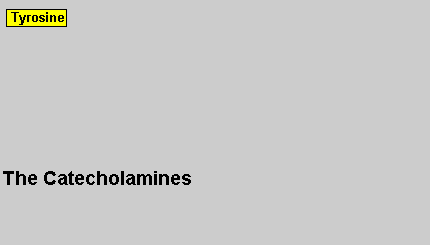
Dopamine, norepinephrine and epinephrine are a group of neurotransmitters called "catecholamines". Norepinephrine is also called "noradrenalin" and epinephrine is also called "adrenalin". Each of these neurotransmitters is produced in a step-by-step fashion by a different enzyme.
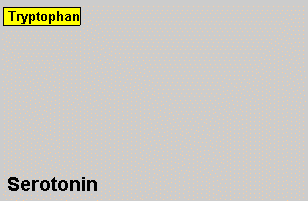
Transport and Release of Neurotransmitters
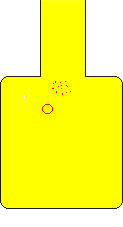 Neurotransmitters are made in the cell body of the neuron and
then transported down the axon to the axon terminal. Molecules of
neurotransmitters are stored in small "packages" called vesicles (see the
picture on the right). Neurotransmitters are released from the axon
terminal when their vesicles "fuse" with the membrane of the axon
terminal, spilling the neurotransmitter into the synaptic cleft.
Neurotransmitters are made in the cell body of the neuron and
then transported down the axon to the axon terminal. Molecules of
neurotransmitters are stored in small "packages" called vesicles (see the
picture on the right). Neurotransmitters are released from the axon
terminal when their vesicles "fuse" with the membrane of the axon
terminal, spilling the neurotransmitter into the synaptic cleft.
Unlike other neurotransmitters, nitric oxide (NO) is not stored in synaptic vesicles. Rather, NO is released soon after it is produced and diffuses out of the neuron. NO then enters another cell where it activates enzymes for the production of "second messengers."
Receptor Binding
Neurotransmitters will bind only to specific receptors on the postsynaptic membrane that recognize them.
Inactivation of Neurotransmitters
The action of neurotransmitters can be stopped by four different mechanisms:
| 1. Diffusion: the neurotransmitter
drifts away, out of the synaptic cleft where it can no longer act on a
receptor.
|
Diffusion |
|
|
 |
|
|
Glial Cells  Astrocyte Image courtesy of Biodidac |
 |
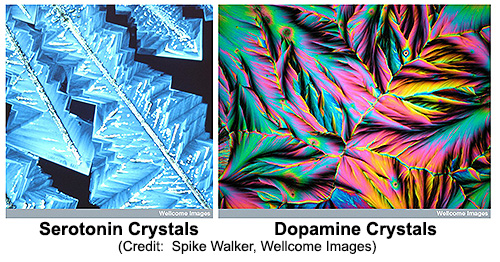
Try it! | Do you like interactive word search puzzles? Make sure your browser is "java-enabled" and try this Neurotransmitters Puzzle |
Did you
know?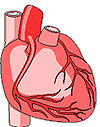 |
The idea for the
famous heart experiment came to Otto Loewi in his sleep. In Loewi's own
words: "In the night of Easter Saturday, 1921, I awoke, turned on the light, and jotted down a few notes on a tiny slip of paper. Then I fell asleep again. It occurred to me at six o'clock in the morning that during the night I had written down something most important, but I was unable to decipher the scrawl. That Sunday was the most desperate day in my whole scientific life. During the next night, however, I awoke again, at three o'clock, and I remembered what it was. This time I did not take any risk; I got up immediately, went to the laboratory, made the experiment on the frog's heart, described above, and at five o' clock the chemical transmission of nervous impulse was conclusively proved." --- quoted from Loewi, O., From the Workshop of Discoveries, Lawrence: University of Kansas Press, 1953. |
Copyright © 1996-2020, Eric H. Chudler All Rights Reserved.
